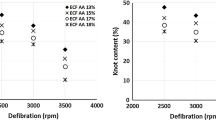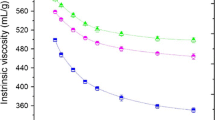Abstract
The aim of this work was to study the impact of cellulose depolymerisation on the beating potential and handsheet properties of the portuguese E. globulus kraft pulp. A homogeneous sample of eucalypt wood chips was cooked using different kraft pulping conditions (cooking temperatures and times, and sodium hydroxide and sodium sulphide concentrations) in order to obtain a wide variation for intrinsic viscosity of the pulps. In the range of industrial cooking conditions, this property was found to be linearly dependent on the effective alkali charge, for a given cooking time and temperature. Unbeaten and beaten (at 2000 rev. PFI) pulp properties were evaluated and the results confirm that the higher the pulp intrinsic viscosity the better the pulp beatability and the paper properties. However, the differences in the latter cannot be exclusively explained by the differences in viscosity, since pulps with the same viscosity may exhibit distinct papermaking potentials. It was then necessary to scan other pulp chemical characteristics that could also influence the development of paper properties such as lignin, pentosan content and polysaccharides relative composition.
Similar content being viewed by others
References
Agarwal, N. and Gustafson, R. (1995) Effect of carbohydrate degradation on zero-span tensile strength. Tappi J. 78, 97-100.
Barzyk, D., Page, D.H. and Ragauskas, A. (1997) Acidic group topochemistry and fibre-to-fibre specific bond strength. J. Pulp Pap. Sci. 23, J59-J61.
Cardwell, R.D. and Cundall, S.B. (1976) The effect of pulping process variables on pulp characteristics and physical properties. Appita 29, 349-355.
Carvalho, M.G. (1999) Effect of cooking variables on the chemical characteristics of E. globulus kraft pulps. PhD Thesis, University of Coimbra, Coimbra, Portugal (in portuguese).
Clark, J. d'A. (1985) Pulp Technology and Treatment for Paper. 2nd ed., Miller Freeman Publications, San Francisco.
Clark, T.A., Allison, R.W. and Kibblewhite, R.P. (1997) Effects of enzymatic modification on radiata pine kraft fibre wall chemistry and physical properties. Appita J. 50, 329-335.
Dias, R.L.V. and Corrêa, S.A.C. (1980) Contribuição para o efeito das variáveis do cozimento em propriedades da polpa de E. grandis. O papel 41, 141-154.
Dillner, B. (1979) A classification of hardwood pulps for paper. In New Pulps for the Paper Industry (L.E. Haas, ed). Miller Freeman, San Francisco, pp. 25-35.
Dillner, B., Ljunger, Å., Herud, O.A. and Thune-Larsen, E. (1970) The breeding of Eucalyptus globulus on the basis of wood density, chemical composition and growth rate. Timber Bull. Europe 73 (Supl 5), 120-153.
Dinwoodie, J.M. (1965) The relationship between fiber morphology and paper properties: a review of literature. Tappi 48, 440-451.
El-Hosseiny, F. and Anderson, D. (1999) Effect of fiber length and coarseness on the burst strength of paper. Tappi J. 82, 202-203.
Fardim, P. and Duran, N. (1998) Tearing strength and kraft pulp chemical composition: a principal components analysis study. In Proc. 5th European Workshop on Ligno-Cellulosics and Pulp, Aveiro, Portugal, pp. 87-90.
Irvine, G.M., Wallis, A.F.A. and Wearne, R.H. (1991) Application of a Monte Carlo procedure to the kraft pulping of eucalypts from the Eden forest resource. Appita 44, 394-398.
Ito, M.H. (1977) The refining of eucalyptus fibre. O papel 38, 99-113.
Laine, J., Hynynen, R. and Stenius, P. (1997) The effect of surface chemical composition and charge on the fibre and paper properties of unbleached and bleached kraft pulps. In Proc. 11th Fundamental Research Symp. Cambridge, England, pp. 859-891.
Lindström, T. (1992) Chemical factors affecting the behaviour of fibres during papermaking. Nord. Pulp and Paper Res. J. 7, 181-192.
Paavilainen, L. (1994) Influence of fibre morphology and processing on the paper making potential of softwood sulphate pulp fibres. In Proc. TAPPI Pulping Conference, Book 2, San Diego, pp. 857-867.
Rydholm, S.A. (1985) Pulping Processes. Robert Krieger Publishing, Malabar.
Scallan, A.M. (1983) The effect of acidic groups on the swelling of pulps: a review. Tappi J. 66, 73-75.
Seth, R.S. and Page, D.H. (1988) Fiber properties and tearing resistance. Tappi J. 71, 103-107.
Shen, W. and Parker, I.H. (1999) Surface composition and surface energetics of various eucalypt pulps. Cellulose 6, 41-55.
Sjöholm, E., Gustafsson, K., Norman, E. and Colmsjö, A. (1997) The effect of degradation on the strength of hardwood kraft pulp fibres. In Proc. 9th Int. Symp. Wood Pulping Chem. Montréal, Canada, pp. 106 (1-4).
Wågberg, L. and Annergren, G. (1997) Physycochemical characterization of papermaking fibres. In Proc. 11th Fundamental Research Symp. Cambridge, England, pp. 1-82.
Author information
Authors and Affiliations
Rights and permissions
About this article
Cite this article
Carvalho, M., Ferreira, P. & Figueiredo, M. Cellulose Depolymerisation and Paper Properties in E. Globulus Kraft Pulps. Cellulose 7, 359–368 (2000). https://doi.org/10.1023/A:1009293924205
Issue Date:
DOI: https://doi.org/10.1023/A:1009293924205




